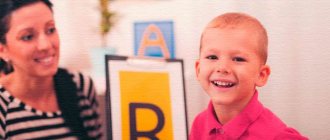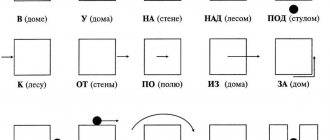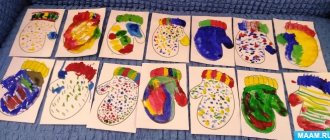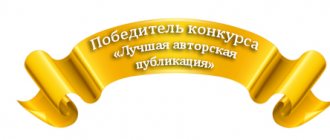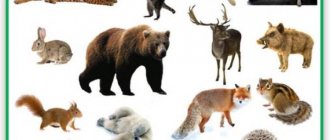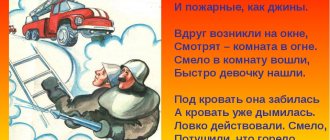Progress of the lesson:
1. Org. moment
2. Game “Guess what disappeared”
Purpose of the game: development of attention and memory.
Equipment: 5–7 toys.
Instructions: look and remember all the toys. Close eyes. Open your eyes and guess what disappeared or appeared. Gradually increase the number of toys.
3. Game "Shepherd"
The goal of the game is to develop the ability to concentrate and distribute attention.
Equipment: a poster with a picture of a herd of grazing cows, a sheet with a picture of one cow.
Instructions: help the shepherd find the cow by signs ( the child is given a sheet with a picture of a cow that he needs to find on the poster).
The child needs to concentrate on several signs: the coloring features of the body, the shape and color of the horns , body, etc.
4. Finger gymnastics
1. Palms on the table (on the count of “one-two”, fingers apart - together.)
2. Fingers shake hands (on the count of “one-two-three-four-five” the fingers of both hands are connected: thumb to thumb, index to index, etc.)
3. Little man (the index and middle fingers of the right and then the left hand run across the table).
5. Game “It happens - it doesn’t happen”
Goal: development of thinking.
Equipment: ball
Progress of the game: the teacher names some situation and throws the ball to the child . The child must catch the ball if the above situation occurs, and if not, then the ball must be returned. Different situations can be offered: dad went to work; a train flies across the sky; the cat wants to eat; the postman brought a letter; salted apple; the house went for a walk; glass shoes, etc.
6. Summary of the lesson : please tell me what we talked about during the lesson ? Remember what games you played.
Lesson 2
Topic: “ Formation of the child’s intellectual sphere ”
Goal: development of mental processes .
Tasks:
1. Development of imagination;
2. Development of short-term memory;
3. Development of thinking;
4. Development of fine motor skills.
Progress of the lesson:
1. Org. moment
2. Game “What’s extra?”
Goal: development of thinking.
Equipment: cards with images of objects
Progress of the game: Place in front of the child three cards belonging to one semantic group, and the fourth from another group (transport and building; animals and a toy; dishes and a book, etc.)
.
The child must highlight the extra card.
3. Finger gymnastics.
1. Goat (extend the index finger and little finger of the right hand, then the left hand)
.
2. Little goats (the same exercise, but performed simultaneously with the fingers of both hands)
.
3. Hares (extend the index and middle fingers upward, connect the thumb, little and ring fingers).
4. Game “Do it as it was”
.
Goal: memory development.
Equipment: 5 pairs of subject pictures and a white A4 .
Instructions: look carefully and remember all the pictures. Put it the way it was.
Help: re-show in case of difficulty.
5. Game “Let’s invent”
Goal: development of imagination.
Equipment: a set of objects of different shapes (sticks, ball, ring, boxes, cylinder)
and cards with images of different objects of a certain
shape - mirror , pencil, egg, apple. The images in the pictures should be similar to objects. For example: a pencil, a fishing rod, a needle, a knife - similar in shape to a stick ;
vase, glass, thimble - a hollow cylinder. Progress of the game: the child sits down at the table , various objects lie in front of him. The teacher sits opposite him and has cards with pictures. The psychologist shows the cards one at a time and asks: What object is like a pencil? The child must find a similar one from a set of objects.
6. Summary of the lesson : what animals did we remember during the lesson ? Remember what games you played.
Lesson 3
Topic: “ Formation of the child’s intellectual sphere ”
Goal: development of mental processes .
Tasks:
1. Development of auditory perception;
2. Development of imagination;
3. Development of thinking;
4. Development of fine motor skills.
Summary of an individual correctional and developmental lesson on the topic: “Let's play with the Bug”
Summary of an individual correctional and developmental lesson by a teacher-defectologist on the topic: “Let's play with the Bug.”
A child of the third year of life with “special” development (encephalopathy, severe PRD).
Goal and objectives: the formation of visually effective and elements of visually imaginative forms of thinking.
develop mental operations:
– by solving problematic and practical problems in the conditions of teaching the method of targeted tests;
– choosing an object – a tool most suitable for its purpose;
– by teaching the transformation of buildings from building material from the original object into 4 new objects sequentially according to the model;
– through the formation of visual perception of object pictures in the conditions of selection and correlation of paired pictures;
– through the formation of the ability to establish the homogeneity of objects;
form sensory standards through the development of practical orientation to the size and shape of objects as the main features;
develop speech activity by developing speech breathing and stimulating the stretching of the lips with the proboscis, activating the pronunciation of the first words - designations, amorphous words and onomatopoeia, as well as by enriching the passive vocabulary with words denoting the characteristics of objects (motley, soft, fluffy, shiny, sharp).
Main method: gaming.
Game plot: the dog came to visit.
Materials: a toy - a dog, a car, 2 braids, 4 cubes, 4 bricks, the author's didactic game "Clown", 2 objects - tools with a slingshot and a ring, a cart with a pin, 4 pairs of pictures, 3 groups of similar objects, a pyramid with 2 rings quantities
Progress of the lesson.
Introductory part. Exercises to develop speech breathing and simulate stretching of the lips with a proboscis. Calmly inhale air through the nose, exhale through the mouth, pronouncing the sound “u”.
1 part. A dog came to us. The dog's name is Zhuchka. Who is this? What is the dog's name? (Singing the song “Here is the dog Bug.” We look at the dog and name what kind of fur it has).
Part 2. The dog wants to play with the car. And the car drove far away. How can we get it? Look, what is this? Rope. Try pulling the string. (Exercise – task with a sliding and false braid “Get the car”). What is this? How does the car sound? What's in her back?
Part 3. There are cubes and bricks in the back of the car. Let's tell a fairy tale for Bug. (Transformation of the original object from building material into 4 new objects sequentially. See Gagarin A.V. Playing with building material // Preschool education. – 2014. – No. 2. – p. 75 – 79).
Once upon a time there was a matryoshka doll. But she didn’t have a house. Let's build a house. What is this? The nesting doll lives in a house. The matryoshka wanted to go on a boat ride. Now let's build a boat. What is this? How does the boat sound? The nesting doll was sailing on a boat, and then she wanted to fly on an airplane. Let's build a plane. What is this? How does the plane sound? The nesting doll flew on an airplane, we need to build a car for it. Let's build a car. What is this? How does the car sound? The doll took a ride in a car and wanted to take a train ride. So the train was built. What is this? How does the train sound? The matryoshka got tired and went home to drink tea. We'll build a house. What is this?
Part 4 The bug liked the fairy tale. She brought you pictures. (Didactic game “Clown”). The clown's toys fell apart. Let us help you sort them out. What is this? This is a square. Run your finger along the edge. These are the corners of the square. What is this? Square. And this is a circle. Run your finger along the edge. No corners. This is a circle. What is this? Let's put everything in its place. (Correlations between silhouette and shape). Show me where the circles are; where are the squares?
Part 5 The bug still wants to play with you. And the cart with pictures rolled far away. Can't reach it with your hand! Look, what is this? These are sticks. And the cart has a pin. Here he is. Try to roll a cart with this stick (with a slingshot). Does not work! Take another stick (with a ring). They used this wand to roll the cart! They put the ring on the pin and rolled it up!
Part 6 Look how many pictures Zhuchka brought you. (Didactic game “Pick a Pair”). This is a bear and this is a bear. Identical pictures. Pair. etc.
Part 7 The bug was playing and mixed up the toys. Let's sort them out. There will be balls here, dolls here, and bunnies here. (Laying out homogeneous objects). What is this? Show me where the dolls, balls, and bunnies are.
Part 8 And Zhuchka also has a pyramid. Let's teach Bug how to assemble a pyramid. Where are the big rings? Where are the little ones? What is this? What rings? Build a pyramid. First put the large rings on the rod, and then the small ones. What are these rings? And these?
Final part. Praise, let's remember what we did today. Parting.

